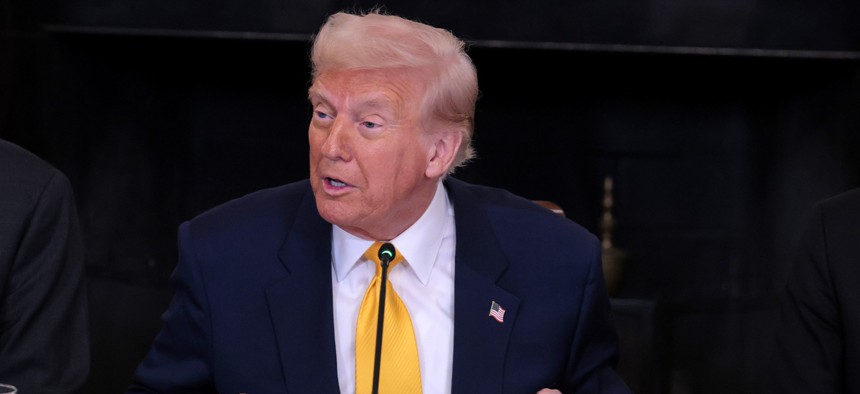Trump aims to sign two stablecoin bills by August, officials say

U.S. President Donald Trump delivers remarks at the The White House Digital Assets Summit at the White House on March 07, 2025 in Washington, DC. Administration officials said at a Wednesday blockchain summit that Trump hopes to sign legislation on stablecoins before the August recess. Anna Moneymaker/Getty Images
The bills both establish a regulatory framework for the issuance and trade of dollar-backed stablecoin.
President Donald Trump hopes to be able to sign two pieces of legislation supporting stablecoin in the U.S. — the House STABLE Act and the Senate GENIUS Act — before Congress goes on recess in August, according to two administration officials who spoke Wednesday during the 2025 D.C. Blockchain Summit.
Bo Hines, the executive director of the Presidential Council of Advisers for Digital Assets at White House, and Tyler Williams, the counselor to the Treasury Secretary on Digital Assets at the Department of the Treasury, discussed the administration’s plans to create a pro-digital asset regulatory environment.
“We want to make the United States the crypto capital of the world,” Hines said. “That means providing a pathway for innovation here. That means creating the most regulatory friendly environment that possibly exists.”
“I think that we will deliver on the president's wishes to see these two bills on this desk before August recess,” he added. “We're just pleased with the work that [Congress is] doing to expedite this process.”
Both bills offer the first federal licensing regimes for digital assets, specifically stablecoins, that are traded in the U.S. Stablecoins are a type of digital asset whose value is backed by a national currency or other commodity. The STABLE Act, formally introduced on Wednesday in the House, outlines a regulatory framework for the issuance and trading of a dollar-backed stablecoin. The GENIUS Act, introduced in the Senate in February, sets similar regulations for the digital asset market, such as licensing regimes, one-to-one reserve maintenance and disclosure requirements, but offers consumers priority in bankruptcy proceedings.
Another key difference between the bills is the STABLE Act’s provision that sets a two-year moratorium on the issuance of any “endogenously collateralized stablecoin” — which maintain their value by relying solely on the value of another digital asset — that is not in existence on the date of the passage of the bill.
In addition to paving the way for stablecoins to flow in the economy, Hines added that Trump is set to receive a series of recommendations authored by an interagency working group that offers actionable insights into digital asset governance strategies.
Williams, who is one of the working group participants, said that members are working expeditiously to honor the deadlines stipulated by a March executive order that strives to establish a strategic bitcoin reserve and U.S. digital asset stockpile while aiming to include a diverse range of stakeholders.
“One of the things I think that we've done so differently… we have an open door policy, we talk to everyone who wants to have their voice heard,” Williams said.
Hines reiterated this point, noting that the goal of federal policy related to digital assets is to create a regulatory environment that is conducive to a thriving private sector.
“We want to know what your concerns are… what challenges you face [in] business here in the United States,” Hines said.
Another step that must be taken to achieve a more crypto-friendly economy is institutional acceptance. Hines and Williams said that the working group is looking to understand how digital asset holders can interact with traditional financial institutions.
“We're going to provide the pathway for institutional adoption to occur, and the way that we do that is really working together,” Hines said.
The Trump administration’s inclusive approach to cryptocurrencies and digital assets is a stark contrast to the Biden administration’s wary posture on crypto trading activity, as exhibited with its restrictions on banks’ ability to hold digital assets and prioritization of fraud mitigation.
In 2023, the Biden administration did take similar steps to the current Trump administration in asking for feedback on research and development related to digital assets with the National Digital Assets Research and Development Agenda.






